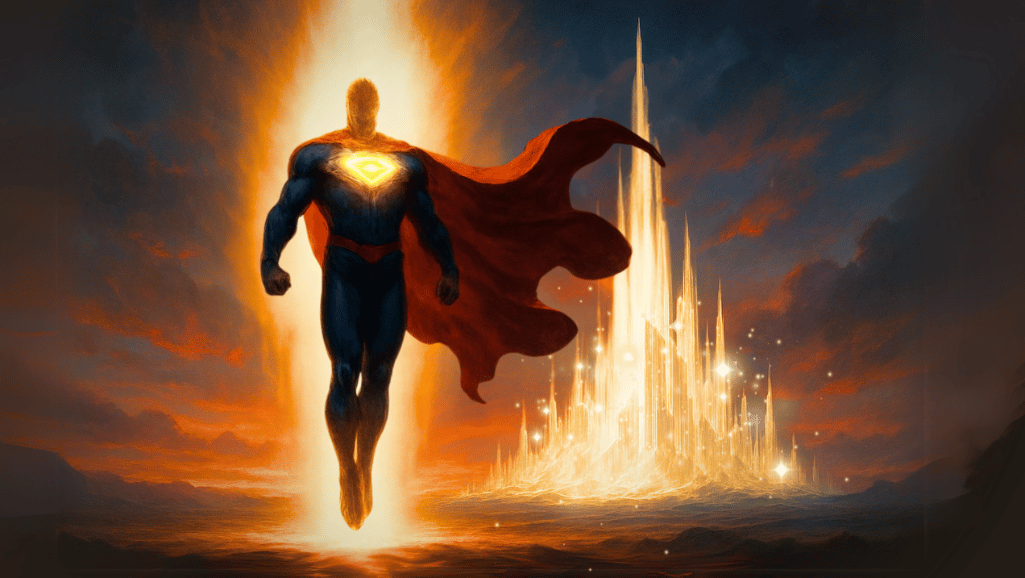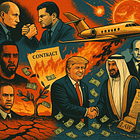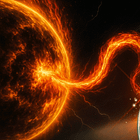The Superman Code: A Myth to Remember Who We Are
Why the Man of Steel Keeps Coming Back When the World Needs to Remember
I grew up in the 1980s believing Christopher Reeve actually was Superman.
Every time we went to the local Blockbuster, all I ever wanted to rent was one of those old Superman movies. I’d race home, change into my blue pyjamas, tie a red towel around my neck like a cape, and stretch my dad’s red undies over my pants. Red wellington boots completed the look. Then I’d press play on the VHS and zoom around the living room, arms outstretched, as John Williams’ heroic score blasted from the tiny speakers of our boxy old television.
And at the end of every film, when Reeve soared past the Earth and smiled right into the camera, I swore he was smiling at me. Like he knew me. Like he was saying, “You’re safe. I got this.”
I know I’m not the only one who felt that way about the Man of Steel.
For some, it was George Reeves in black & white. For others, it was Dean Cain in Lois & Clark, or Brandon Routh, or Henry Cavill. It doesn’t really matter which actor wore the tights. What matters is what they represented.
Because Superman isn’t just a hero.
He’s a message.
A myth.
A memory wrapped in a red cape and a clean jawline.
Superman is a code - and he shows up in the human story every time we’re about to forget who we are. He’s the archetype of the Returner – the one who comes back not to change the story, but to remind us it’s not over yet. To remind us who we really are.
Lately, I’ve been thinking about Superman a lot. Not the grim, brooding versions we’ve seen in recent years - the armored alien who can barely connect to Earth. (Don’t come for me, Cavill fans. He was great. Just not my personal cup of truth.)
I’m talking about the real Superman.
The one who remembers.
And I don’t think it’s an accident that he’s returning now.
There’s a new Superman film set to release this July (no, this isn’t a paid promo - just a cosmic breadcrumb). And from all early signs, it looks like this one gets it. Like it’s reaching back for the soul of the myth. Like it remembers the version that stirred something ancient. Something holy. Something true.
Because let’s be honest:
The world doesn’t need another antihero.
It needs a memory.
And maybe a reason to believe in goodness again.
He Came from a Fallen World to Save This One
Superman was created in 1938, in the shadow of Hitler’s rise, by two Jewish teenagers in Cleveland. Jerry Siegel and Joe Shuster weren’t just inventing a hero - they were summoning a protector. Siegel’s father had been killed during a robbery. They lived in a world on the brink. And what emerged from their pain wasn’t just fantasy. It was soul-level transmission.
An alien child from a dying world.
Sent in a capsule of light.
Raised by Earth parents, but not of this Earth.
Gifted with powers he doesn’t yet understand, and a responsibility he can’t ignore.
Tell me that isn’t the Atlantean story in disguise.
Superman is the archetype of the Fallen Lightbringer - those of us who lived through the fall of higher civilizations, who survived the collapse of ancient worlds, who cloaked ourselves in flesh and walked among 3D humanity not to rule, but to remind.
There’s a particular ache that comes with remembering who you are in a world that forgot.
Superman represents that ache.
He’s not just a random fiction.
He’s a mirror.
Kal-El Means “Voice of God”
You think that name was accidental?
“Kal-El” pulses with ancient resonance.
In Hebrew, “El” denotes divinity - it appears in sacred names like Elohim, Gabriel, and Michael. Superman’s creators, both Jewish, weren’t just naming a character. They were encoding a frequency. While “Kal-El” doesn’t literally translate in Hebrew to “voice of God,” it vibrates with the symbolism of a divine messenger - not just a hero, but a transmission from the stars.
The truth is: Kal-El isn’t just a name. It’s a key.
In the Atlantean tongue, “Kal” was a sacred syllable - a vibrational current denoting pure Source energy in motion. It was the sound of light being made manifest. “El” marked divine origin or celestial authority. It spoke of those who carried the codes.
Together, Kal-El can be remembered as “The Light Current of God” or “Divine Energy in Motion.”
He wasn’t just a being.
He was a codex.
A carrier of sacred architecture.
A myth wrapped in flesh, reminding us of a time when power meant protection, when beings didn’t come to conquer, but to restore harmony across dimensions.
The last son of a dying world.
Sent to Earth in a crystal ark.
Raised among mortals.
Bringer of justice. Defender of light.
A walking resonance of what we once were, and what we could be again.
Kal-El is not just a superhero.
He’s a memory.
An echo of Atlantis.
A transmission from the Golden Age,
when light wore form and gods walked beside us.
And that famous “S” on his chest?
It’s not an S.
It’s a sigil.
A symbol of hope.
A frequency glyph from his home world.
We’re meant to recognize it - not with logic, but with remembrance.
In the bones. In the soul.
In the part of you that stood at the edge of Atlantis and chose to stay.
To rebuild. To walk with humans.
To hold the field, even in the dark.
Maybe the glasses were never just his disguise.
Maybe they were ours, too.
The Power Was Never Flight. It Was Mercy.
Here’s the truth about Superman that is rarely spoken:
His greatest strength isn’t flight, heat vision, or brute force.
It’s restraint. It’s compassion. It’s that aching, lonely knowing: I could destroy everything. But I choose to protect it instead.
He doesn’t wear the cape to dominate. He wears it to serve.
And if you’ve ever felt the pain of being more than the world can see, of holding back your fullness so others can feel safe, of carrying a silent mission no one understands, then maybe you’ve been wearing one too.
He Returns at the Turning Points
Every time the world hits a threshold, the Superman myth pulses back into culture - not just as entertainment, but as an archetypal calibration. A signal. A soul prompt. A reminder of what power could look like if wielded with compassion.
1938 – The Great Depression. Fascism rising.
Action Comics #1. Superman is born. A working-class hero who fights corrupt landlords and street thugs. Truth, justice, and punching Nazis.
1952–1958 – Post-war optimism. Cold War paranoia.
George Reeves brings Superman to black-and-white TV. The dad-like protector America needed - calm, upright, never rattled. Nuclear anxiety in the air, but order restored by truth and trousers pressed.
1978 – Watergate wounds. Cold War chills. Hope wearing thin.
Christopher Reeve arrives. Graceful, good-hearted, messianic. The Superman who heals. His smile didn’t just save Lois - it saved us from cynicism.
1992 – Economic recession. Cultural fragmentation. Heroes falling.
The Death of Superman. In the comics, he dies battling Doomsday. The symbol collapses. America questions whether icons can survive a world like this. Grief goes mainstream.
1993–1997 – The Clinton boom. Tabloids. Relationship angst.
Dean Cain in Lois & Clark. A romantic Superman, just trying to have it all - career, love, identity. Less god, more guy. The cape got domestic.
2001–2011 – 9/11, Iraq War, teen identity crisis culture.
Tom Welling in Smallville. A decade-long prequel. Clark learns who he is while the world wrestles with the same question. Truth in a world addicted to secrets.
2006 – Post-9/11 grief. Empire fatigue.
Brandon Routh in Superman Returns. A ghost of the Reeve legacy, haunted and heavy. We were trying to remember the light but hadn’t healed yet.
2013–2023 – Surveillance state. Disinformation. Corporate overlords.
Henry Cavill’s Superman lands hard. Armored. Alienated. Watching humanity from above but unable to connect. Power over presence. We made gods, but not friends.
2025 – Systemic collapse. Planetary awakening. Soul-level remembering.
David Corenswet is next. And early signs say: the real Superman is back. The myth is remembering itself.
This isn’t marketing. This is mythic calibration.
A red cape across the sky saying, “Remember who you are.”
The Superman archetype shows up not to entertain, but to recalibrate the collective. To whisper: You are more than you think you are. You came here for more than this.
You Don’t Need to Watch the Movie. You Are the Movie.
If this stirs something in you, it’s not nostalgia. It’s soul memory.
You came from a fallen world too.
You survived something no one talks about.
And like him, you landed here.
Different. Disguised. Carrying codes you couldn’t yet name.
You don’t have to save the world.
But you do have to remember why you came.
Because when Superman flies again this July, millions will cheer.
But a few of us?
We’ll remember.
We’ll feel it activate something buried but burning:
The part of us that came to hold the line.
The part of us that knows.
The cape isn’t coming to save us.
It’s coming to remind us we were always the ones wearing it.
And maybe - just maybe - this time around, we’ll stop pretending to be Clark Kent.
And start answering to the name Kal-El.
My intention in my writing is to lessen the climate of fear around world events by offering clarity and cosmic context for what’s unfolding; to bring context to the chaos. I believe our highest calling right now is to anchor in the vibration of love and call in a more beautiful world, and to do that, we must lean out of fear. I hope you read this with an open, uplifted heart.










I love the back stories in this!
I love this piece! And while I never been a big comic book fan I have seen anything superman from the early 2000s and forward. I never noticed when the movies/TV shows came out and what was going on during the times they did. You made those correlations beautifully and it makes so much sense.
I have also noticed from roughly the 2010s and on where Disney and Pixar movies have been changing there messages too to really deep soulful topics like the movie Soul and Inside Out. Very interesting these came out leading up to this current administration.